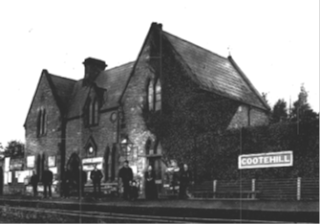As I sat eating a Solero outside Mullen's bar in Cootehill, Co.
Cavan, my mind wandering to the potential architectural treasure I was about to
encounter, a cry from a discernible gentleman in a passing car of ‘gevas a lek!’
shattered me back to reality. Time to move on.
Taking the road to Bailieborough I stopped after a five
minute march, seeing the high-speed road curve ahead of me and the pavement
disappear. “I’m not risking my life for a stat-” and there it was to the
left of me, tucked away discretely with the later addition of the manure-soaked aptly-named Station Road Mart plonked where the tracks used to be. Cootehill railway station.


Designed by William G. Murray and built for the Dundalk & Enniskillen Railway Company in 1860, the station closed to passengers and goods in 1947, finally closing forever in 1955. The station’s gothic splendour lifts its small stature to higher levels (perhaps it’s growing to escape the neighbouring cow pats), with exquisite hammered stone crafted minutely into this symmetrical structure. Ogee carved stone lintels give an ecclesiastical feel, whilst the entry bargeboards designate the building to utilitarian and not Unitarian use.
A peek through the metal-grid protected windows shows an
interior adapted into a cattle-traders’ canteen, with service paid to the
original features such as a retained fireplace, painted sills and preserved
door and window frames. A visit to the adjacent urinals accessed from the
former platform demonstrated that there is such a thing as too much intrigue. A
comparative photo on Buildings of Ireland’s archive shows that the roof has
been replaced and the station conserved – thank goodness for cows.
 |
| Cootehill Station, front elevation, Buildings of Ireland |
A bit of online searching locates photos of the station in operation, with one (as I will always bemoan) focusing on the locomotive at the expense of the station it's serving. The uniformed employee and the waiting passengers evoke a sense of modern connectivity: here is a woman, child and worker all making use of technological industry in the muddle of Ireland’s midland.
 |
| Image from Cavan Libraries |
 |
| Image from www.irishrailways.blogspot.com |
A waft of countryside tangs the nostrils and standing alone looking at a stoic monument to Ireland’s railway past, I wonder if the cycle of human activity is so intertwined with our basic need for fodder that engineering and architecture act as a hyper-advanced civilised blip on an otherwise permanently manured landscape.
Time indeed to moove on.
